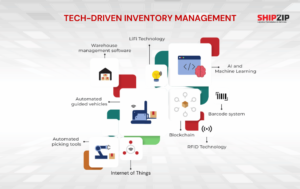
13.09.23
Given India’s vast geographical expanse, burgeoning e-commerce industry, and diverse demographics, the spotlight is increasingly shifting towards optimizing warehouse efficiency within the warehousing sector. The data speaks for itself: a Q1 2023 report by Savills India reveals an absorption of nearly 11 million square feet in warehousing, with a staggering 77% demand from tier-I cities. Such data highlights the scale of growth and the transformative role of warehousing from mere storage points to strategic assets.
Major cities such as Delhi-NCR, Mumbai, and Bengaluru are at the helm of this transformation, further underscored by the 52% rise in demand for premium, grade-A spaces.
Having understood this massive upswing, the success of any business, whether giants like Flipkart, Amazon, and Reliance, or the emerging players, is intricately tied to how they navigate the warehousing challenge. The efficiencies they embed into their warehousing strategies can define their overall business efficacy, especially in the fast-paced e-commerce sector. This blog aims to delve into the strategies that are shaping this landscape.
Effective warehouse management seeks optimal space utilization, efficient material handling, and adaptability to changing storage demands. The Pareto rule underscores that 80% of warehouse actions are due to just 20% of items—the high-demand ones. Understanding this, alongside the activity of medium and slow-movers, equips managers to tackle challenges like sudden growth or outdated stock.
Remember, the essence of warehouse optimization lies in constantly evolving and adapting to the changing landscape of supply chain dynamics.
With urban real estate prices soaring, especially in metropolises like Mumbai and Bengaluru, the vertical expansion of warehouses is both an innovative and practical solution. This method not only optimizes space but significantly cuts down on storage expenses. International retailers entering the Indian market, like IKEA, have also tapped into this strategy, creating multi-tiered storage systems.

Diversity is the hallmark of India’s consumer market. This diversity translates into an extensive inventory mix in warehouses. AI-driven inventory systems can categorize, track, and manage stocks in real time. RFID & IoT technologies & predictive capabilities also anticipate stock shortages or overages, ensuring optimal stock levels and minimizing storage costs or emergency procurement costs.
And for the fact according to a report by Research and Markets, the warehouse automation market is projected to expand at a CAGR of approximately 15% from 2022 to 2027.

At first glance, ergonomic layouts might seem more about worker welfare than cost efficiency. However, a well-designed, ergonomic warehouse layout facilitates smoother, quicker operations. By reducing the time taken to retrieve items and minimizing errors, businesses can speed up their supply chain, thus serving customers faster and reducing operational hours.
Furthermore, a layout that caters to the well-being of the employees can decrease health-related absenteeism, ensuring consistent productivity and reducing potential hiring or training costs for temporary replacements.

India’s diverse climate poses challenges in product storage, especially perishables. The FIFO system isn’t just about financial efficiency; it’s a pledge of quality. For businesses dealing with perishables, this becomes especially crucial in cities with high humidity levels, like Kolkata or Chennai.
By implementing FIFO, businesses ensure that products are always fresh, reducing wastage due to spoilage. This strategy, while ensuring product quality, also guards against financial losses tied to discarded products.

Sustainable warehousing practices are not a mere afterthought. Solar panels, rainwater harvesting, and energy-efficient lighting are some green initiatives warehouses are incorporating. They not only result in cost savings but also appeal to the environmentally-conscious Indian consumer.

An Answer to the ‘Instant Delivery’ Dilemma. The Indian consumer’s appetite for quick deliveries necessitates strategies like cross-docking. By directly transferring products from inbound to outbound vehicles, storage times and costs are reduced dramatically. Pioneers in this strategy, like DHL, have showcased the immense potential of this approach in the Indian context.

Employee Cross-training isn’t just about flexibility but is an embodiment of the Indian ethos of ‘Jugaad’ – a colloquial term for finding low-cost solutions to problems. By cross-training, warehouses not only maximize manpower but also ensure that every inch of the facility is used productively. The fluidity it brings to operations ensures less idle space, directly translating to cost savings.

Metrics are universal, but the priorities might vary. Given the multitude of goods catered to varied demographics, understanding specific KPIs can shed light on space wastage. For instance, in cities like Mumbai, where real estate is expensive, a slight misjudgment in space allocation can result in significant costs. Acting on these KPIs ensures that warehouses in such prime locations are used to their utmost capacity, ensuring substantial savings.

These systems aren’t just about inventory tracking; they redefine how warehouses operate. By coordinating every aspect of warehousing operations, a WMS ensures that tasks are carried out efficiently. This leads to two primary outcomes: First, it ensures that every nook and cranny of the warehouse is effectively utilized, leading to superior space optimization.
Second, it brings about notable cost efficiency by reducing manual errors, minimizing the need for labour-intensive oversight, and providing data-driven insights for better stock placement.

Custom Replenishment Strategies resonate deeply with the subcontinent’s diverse consumption patterns. North might love its wheat, while South prefers rice. Ensuring warehouses stock up based on regional consumption ensures no space is wasted on items with lower turnover rates. This strategy not only optimizes space but also prevents dead investment in slow-moving goods, offering a clear path to cost efficiency.

At ShipZip, we’ve meticulously woven the aforementioned strategies into our operational fabric, directly addressing India’s unique warehousing challenges. By leveraging AI-driven systems, incorporating ergonomic and green initiatives, and adopting region-specific strategies, we’re not just offering warehousing solutions; we’re setting industry benchmarks.
As we navigate this dynamic landscape, our commitment remains unwavering: to provide our clients with the most innovative and cost-efficient logistics services, solidifying our position as pioneers in the market.
The ever-evolving Indian commerce landscape demands that businesses continually refine their warehousing strategies. From the towering skyscrapers of Mumbai to the bustling markets of Bengaluru, the efficient use of warehouse space stands as a cornerstone for ensuring cost-effectiveness and meeting customer expectations.
Whether it’s leveraging vertical space, harnessing the power of technology, or placing emphasis on sustainable practices, the strategic nuances presented above highlight the multi-faceted approach businesses must adopt to thrive. The fusion of traditional wisdom, like ‘Jugaad,’ with cutting-edge innovations paints a promising future for India’s warehousing sector.
As businesses strive to perfect their operations, it’s clear that the warehouse efficiency, often hidden away from the limelight, will play a starring role in India’s e-commerce story, paving the way for a new chapter of growth, efficiency, and customer satisfaction.